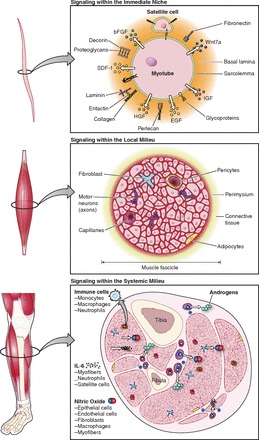Figure 3.

The satellite cell niche. A: satellite cells reside between the basal lamina and the sarcolemma of adult skeletal myofibers and as such are influenced by structural and biochemical cues emanating from this microenvironment. A complex set of diffusible molecules (e.g., Wnt, IGF, and FGF) are exchanged between the satellite cell and the myofiber to maintain quiescence or promote activation. In addition, numerous extracellular matrix components and cellular receptors are present either on the surface of the sarcolemma, satellite cell, or contained within the basal lamina. These components comprise the immediate niche of the satellite cell and dictate rapid changes in the satellite cell state. B: the muscle fascicle defines the extremities of the local milieu an environment that is more diverse compared with the immediate niche due to the heterogeneity of cell types and signaling factors. The local milieu surrounding the satellite cell is made up of other myofibers in addition to interstitial cells, capillaries, and neuromuscular junctions. Each of these cell types influences the surrounding environment and thereby affects the state of the satellite cell. C: the systemic milieu contains the greatest diversity with which the satellite cell is influenced. Exposure of satellite cells to the host's immune system, and circulating hormones along with the skeleton and surrounding skeletal muscles present the broadest environment for the satellite cell. Changes that occur in the systemic milieu affect the satellite cell gradually. Prolonged exposure of signals from the systemic milieu plays an important role in the ability of satellite cells to participate in multiple rounds of regeneration.
